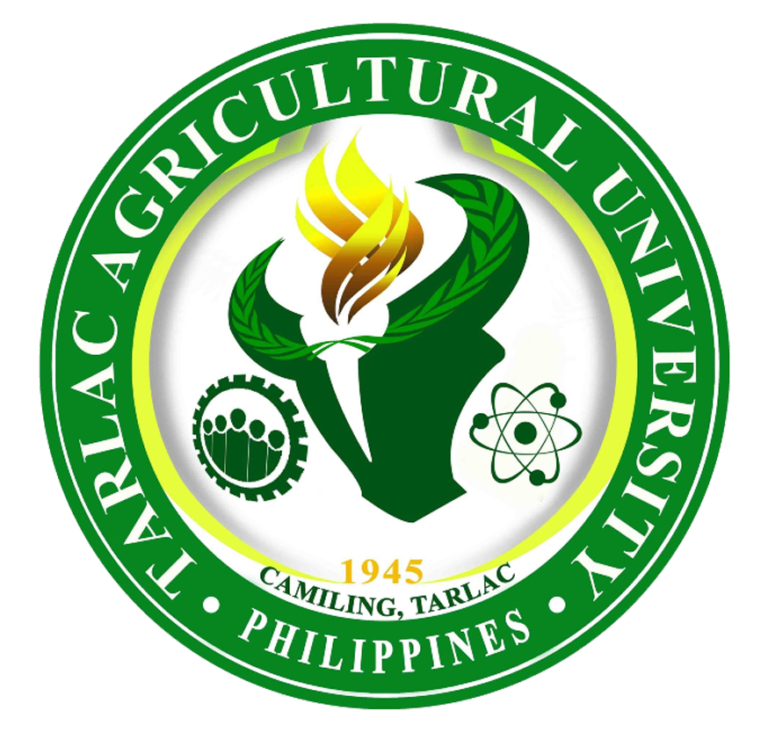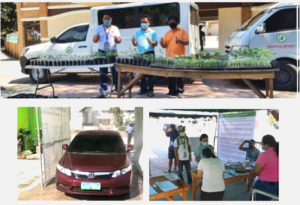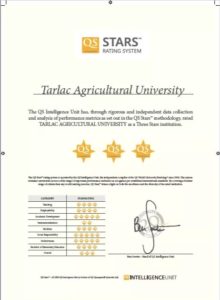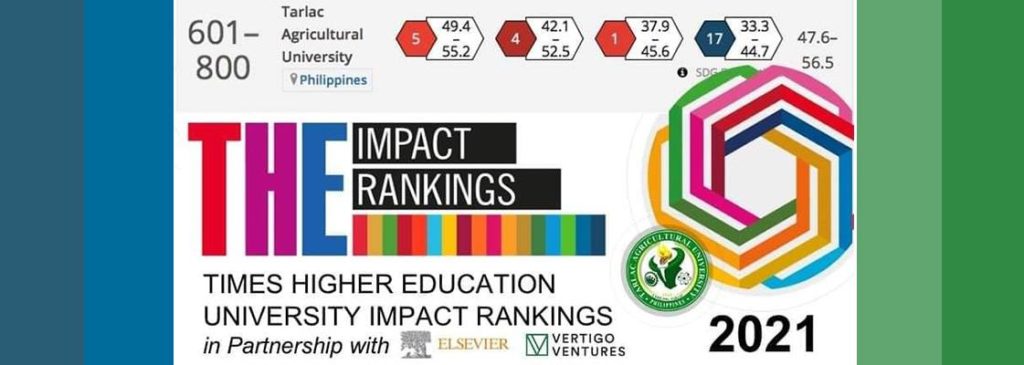
Tarlac Agricultural University
The carabao has always been the symbol of the Tarlac Agricultural University (TAU). The carabao is resilient even through the ages, synonymous to actions and sustained accomplishments – that is TAU through the years. It is always good to go back to memory lane and learn how the University has weathered storms before reaching its present status.
The Institution was established in 1944 as Camiling Boys/Girls High School. It started with 368 students, 13 faculty members and a school principal. It stopped operation in December 1944 but resumed after the Liberation as Tarlac High School, Camiling Branch. The reopening of the school was a response to the clamor of parents whose children stopped schooling during the war years and the difficulty of traveling from Camiling to Tarlac City.
On July 6, 1945, Municipal Resolution No. 34 created the Camiling Vocational Agricultural School (CVAS) replacing Tarlac High School, Camiling Branch. Its focus on vocational agriculture was considered a means to hasten the economic recovery of the town from the ravages of the war. CVAS had 534 students and 13 faculty. From 1945 to 1948, the school offered two curricula – the general academic to enable the former students to graduate and the agriculture curriculum for the first year and second year students.
On September 26, 1946, the school was renamed Camiling Rural High School (CRHS). In 1948, the general curriculum was phased out. Early in 1952, the Director of Public Schools served notices that the school should be relocated to a permanent site and increase the declining enrollment; otherwise it might be closed or transferred to another town.
The most conducive for an agricultural school’s expansion was found in Malacampa, a barangay seven kilometers away from the town proper. In June 1953, the school with 155 students and eight faculty moved to the new site. Classrooms and offices were made of bamboos and nipa in the “middle of a wilderness.” Funds from FOA-PHILCUSA later came and permanent buildings replaced the bamboo structures.
Expansion and development had been accelerated when CRHS was converted to Tarlac National Agricultural School (TNAS) in 1957, under a Superintendent. It became a policy to make all projects profitable – piggery, poultry, goat and vegetables. Linkaging for research started from pork barrel funds. In 1961, the two-year technical agriculture post-secondary course was opened and in 1963, the Health Center was built out of funds from the Philippine Charity Sweepstakes Office (PCSO). By that time, TNAS already had a school hymn and a student publication, “The Carabao.”
In 1965, TNAS and Tarlac School of Arts and Trades (TSAT) were merged to become the Tarlac College of Technology. TNAS became TCT-College of Agriculture (TCT-CA) while TSAT became the Tarlac College of Technology – College of Arts and Trades (TCT-CAT) by virtue of RA 4337. TCT-CA offered three degree programs: Bachelor of Science in Elementary Education major in Elementary Agriculture or Home Economics (BSEEd); Bachelor of Science in Agriculture (BSA) major in Crop Science/Animal Science and Bachelor of Science in Agricultural Engineering (BSA Eng’g). Government programs related to agriculture, especially after the declaration of Martial Law in 1971 gave a boost to the enrollment in these courses. Graduates found immediate employment here and abroad. From all indications, the school could well become autonomous.
Thus, on December 18, 1974, by virtue of PD 609 issued by President Ferdinand E. Marcos, the Institution was created as a state college. The first College President was Mr. Jose L. Milla. During President Milla’s stewardship, the campus area was increased to 60 hectares; a forestry laboratory in Titi Calao, San Jose, Mayantoc was acquired through PD 1506; Fishery was added to the existing production projects and joint researches with IRRI were undertaken. Enrollment further increased as well as the number of faculty and non-teaching personnel.
The second College President was Dr. Robustiano J. Estrada. Upon his assumption, the ten-year development program and the TCA Code were prepared. There was a major reorganization in the administrative set-up of the College. Two vice presidents were designated: the Vice President for Administrative and Business Affairs took care of the non-academic staff and functions while the Vice President for Academic, Cultural and Sports Affairs was in- charge of the academic programs based in different institutes under a Dean. There was an exodus of faculty to take graduate studies because of the promotion scheme of state universities and colleges that gave highest point to educational attainment.
Infrastructure development was also accelerated under Dr. Estrada’s administration. Academic buildings rose to accommodate enrollment that reached thousands and which increased every year. Twenty-one faculty cottages, the Girl’s Dorm and Boy’s Dorm, a guest house, six-door staff apartment, a research and development building, a multipurpose building, the administration building cum library and the chapel were all constructed.
The old structures were repaired and PAG-ASA established an Agro-Meteorological Station. These gave a new look to the campus. By then, the campus has expanded to 70 hectares, including a four-hectare athletic oval. Research and extension also expanded and TCA became a byword among households in the service area. The production projects also increased notably, rice, vegetables, piggery, poultry, goat, cattle, nursery, fruit trees, seedlings and canteen service. Dr. Feliciano S. Rosete became the 3rd President of TCA when Dr. Estrada’s term expired in 1989. During the first five years of Dr. Rosete’s term, other infrastructures came about. The landmark was the Farmers’ Training Center built from the Countrywide Development Fund (CDF) of then Senator Alberto G. Romulo. It was also during Dr. Rosete’s term that scholarships from private individuals and NGOs started pouring in, and more curricular programs were offered. Extension and research accomplishments also multiplied.
In 2001, Dr. Philip B. Ibarra became the 4th President of TCA. His administration is noted for sustaining the gains and glories of the past while working out for more. TCA then was notable for revolutionizing its curricular offerings, computerization of enrolment and administrative system, aggressive accessing of financial and material resources, development of new leaders, aggressive accreditation of programs and strengthening existing partnerships with local and international organizations. All these initiatives have Pushed TCA to be the Best Institution through Transparent and Caring Administration.
On January 14, 2010, Dr. Max P. Guillermo, assumed the presidency of the Institution. He pursued a new strategic planning initiative: TCA @ 2015 that outlined the formulated institutional plans, based on strategic programmatic strengths supported by a comprehensive development plan to make the then TCA an energized incubator of new ideas and center of innovation. Significant milestones in the realization of the vision to be a recognized higher education institution in the Southeast Asian Region are greatly demonstrated during the second term of Dr. Guillermo.
His term is characterized by a more aggressive and more vigorous actions all directed toward its persistent pursuit of quality and excellence. Intensified mechanisms in the realization of the Institution’s quest for quality assurance are the landmark accomplishments of Dr. Guillermo’s administration. It is under his administration that the Institution had been awarded an institutional accreditation status making a record as the first AACCUP Institutionally Accredited State College in the Philippines, the second SUC granted institutional accreditation by AACCUP under the outcomes-based quality assurance (OBQA) paradigm, and the fourth SUC awarded institutional accreditation status by AACCUP. As it strives to achieve the highest levels of excellence in delivering higher education, TAU has also undergone Institutional Sustainability Assessment (based on CMO No. 46, s. 2012) conducted by CHED.
On January 1, 2016, the Agriculture Education of the College of Agriculture and Forestry was designated by the Commission on Higher Education (CHED) as Center of Development (COD), whereas, the Teacher Education programs of the College of Education were certified by CHED as Center of Excellence (COE) effective April 1, 2016. Furthermore, all the 23 program offerings of the University are already accredited, most of which are submitted for higher accreditation status.
On May 10, 2016, a major historical leap for the TCA has been taken as it was officially converted into TAU by virtue of Republic Act No. 10800, “An Act Converting the Tarlac College of Agriculture in the Municipality of Camiling, Province of Tarlac into a State University to be Known as the Tarlac Agricultural University,” signed by His Excellency President Benigno S. Aquino III.
TAU is mandated by law to provide advanced education, higher technological, professional instruction and training in the fields of agriculture, agribusiness management, science and technology, engineering, teacher education, non-traditional courses, and other relevant fields of study. It shall also undertake research, extension services, and production activities in support of the development of the Province of Tarlac, and provide progressive leadership in its areas of specialization.
The change in status and shift in perspective pose immense challenges to TAU, to which an effective, in-depth, well-planned, and well-executed strategic development plan is imperative to sustain quality, competence, and competitiveness in agricultural education and all its allied courses. The TAU Strategic Development Plan (2016 to 2025) has been crafted through the stakeholders’ combined wisdom and vision for TAU. It serves as the blueprint of the ten-year strategic directions carefully laid out to realize the University’s breakthrough goals.
Eyeing a spot in the global academic map and be recognized as one of the top performing agricultural universities today, the University has intensified and strengthened its global partnerships, linkages and collaborations to expand its network, broaden its prospects, and strengthen resource generation initiatives. As of 2017, the University has established numerous linkages and memberships with institutions and organizations in the international milieu. These collaborations and partnerships paved the way for faculty exchange and numerous research paper presentations and opportunities for sending OJT students abroad. All of these also ushered diversified avenues for international (cross-border) mobility of students and professional advancement of faculty members.
On December 28, 2017, the Research Extension & Training Office completed the Research, Extension and Training Office Quality Management System audit as compliance with the requirements of ISO 9001: 2015. The Management of Certification Association “Russian Register” signified their issuance of the Certificate of Conformity.
Consequently, the Russian Register awarded the ISO 9001:2015 Quality Management System (QMS) Certification to the TAU-RET QMS Core Group on February 9, 2018. Being ISO certified, the TAU-RET is committed to improving its performance continually and aims to achieve university-wide QMS 900:2015 certification. With the support of the administration, the TAU-RET successfully passed the first surveillance visit of the Russian Register last January 31, 2019. Having recognized as a Level IV State University, TAU achieved excellence in undertaking the full range of its functions as a state university/college; namely, instruction, research, and extension manifested through teaching effectiveness, research competence, active community services, and efficient management of resources.
Upon reaping all the success from several years of hard work, the University has been declared as a Level IV State University, as per the CMO No.12, s. 2018 and this is under the DBM-CHED Joint Circular No. 1 s. 2016, otherwise known as the FY 2016 Levelling Instrument for SUCs and Guidelines for the Implementation Thereof.
An evident change in TAU’s environment is also observed with the massive infrastructure projects designed to cater to the ever-changing needs of its stakeholders. The rise of new structures and rehabilitation of existing buildings that house well-ventilated and spacious classrooms together with well-equipped laboratories has been a priority of the University administration.
- Academic Network of Psychology and Social Science Department
- Accrediting Agency of Chartered State Colleges and Universities in the Philippines
- Asian Association of Veterinary Schools
- Association of Colleges of Agriculture in the Philippines
- Central Luzon Agriculture and Resources Research and Development Consortium
- Council for Economics Educators
- Council of Deans of Colleges of Education in Region III
- Global Workers and Family Federation Inc.
- Graduate Education Association of Chartered Colleges and Universities in Region III
- Institute of International Education
- International Society for Southeast Asian Agricultural Sciences
- Management Association of the Philippines
- National Seed Industry Council
- Philippine Association for Graduate Education
- Philippine Association of Extension Program Implementers
- Philippine Association of State Universities and Colleges
- Philippine Association of Teacher Education (Region III)
- Philippine Association of Veterinary Medicine Educators and Schools, Inc.
- Philippine Guidance and Counseling Association
- Philippine Science Consortium
- Philippine Society of Information Technology Educators
- Psychological Association of the Philippines
- State Universities and Colleges Teacher Education Institution, Inc. – Region III
- United Nations Educational, Scientific and Cultural Organization
- University Mobility in Asia and the Pacific Council
TAU sustains Anti-COVID-19 initiatives in the new normal

As with other establishments and institutions, the TAU Task Force sustains its efforts in implementing safety protocol measures against COVID-19 pandemic when work resumes at TAU after the national government placed the Tarlac province under General Community Quarantine (GCQ) on May 16.
After work was suspended for 58 days when Tarlac was under the Enhanced Community Quarantine, all TAU employees who returned to work as part of the TAU skeletal workforce followed strict Anti-COVID-19 protocols as initiated by the TAU Medical and Dental Services Unit. The skeletal workforce members also adapted the alternative work arrangement as per the Philippine Civil Service Announcement No. 13 s. 2020 released on March 17, 2020. Employees experiencing symptoms like cough, headache, and colds are not allowed to enter the University. Visitors may be given entry subjected to the approval of the TAU Task Force. Meanwhile, the “vulnerable” employees such as the senior faculty/personnel, pregnant women, students age 21 years old below, and PWDs shall not report to the University, instead they will be doing their tasks/work from home.
As the pandemic paralyzes the world’s economy, the University discouraged face-to-face classes and opted to adopt distance learning mode. Faculty and students gradually coped up with the new method of handling of classes during the ECQ period. The Commission on Higher Education (CHED) did not recommend the mass promotion for all the students enrolled during the ECQ period despite the strong call from the students experiencing difficulty accessing the internet to accomplish their remaining requirements online. To address the students’ predicaments, the TAU Academic Council released implementing guidelines in adjusting online classes into flexible learning mode, so the students who lack resources in engaging to online classes can still catch up with the lessons asynchronously and could still comply with the requirements assigned to them for the semester.
When the national government strictly implemented travel ban during the ECQ, many of the TAU students were stranded at their dormitories. With the College Deans and faculty’s efforts, the administration supported the necessities of their stranded students. The TAU Task Force regularly provided the students with food supply during the ECQ period. With the approval of the IATF, the TAU Task Force also initiated its own “Balik Probinsiya” program. The administration arranged transportation and ensured the safe travel of the stranded students as they returned to their home provinces.
Meanwhile, the TAU Office of Student Services and Development, the Guidance Counselors and Psychometricians offered free consultation via online chat or calls for all employees and students experiencing mental health issues and anxiety amidst the pandemic situation.
The TAU Task Force also initiated the mobile cashier service to deliver the TAU personnel salary with Contract-of-Service and Job Order status in a specific meeting point while the province was under the ECQ. TAU initiated the delivery of one sack of rice at the doorstep of every TAU employee as means of support to employees and their families.
As the situation eased up a bit and the TAU academic community realized the impact of the pandemic to the education sector, the Office of Vice President of Academic Affairs (OVPAA), in collaboration with Office of External Linkages and International Affairs (ELIA), pursued the preparation for the flexible learning under the new normal. Consequently, they initiated the TAU Webinar Series for the TAU faculty, which they made public via Facebook Live, so this would be accessible to all educators needing support about the Education 4.0.
To adequately prepare learning solutions towards the realization of Education 4.0, the TAU academic community is urging the need for IT hardware and software, a virtual learning management system, and upgraded technology resources for flexible learning. Included in the University’s plans for the new normal, TAU faculty have started preparing Learning Resource Packets (LRP) for the upcoming first semester. These LRPs included the syllabus, supplementary readings, and activities the students must accomplish for their flexible learning. With the approval of the Board of Regents (BOR) and the Academic Council, TAU pursued the offering of midyear classes in the graduate programs.
Though the Tarlac province was already placed under the Modified General Community Quarantine, COVID-19 patients increase by thousands nationwide every day. Hence, the TAU- Admission and Registration Services encouraged the conduct of online enrolment for the first semester of SY 2020-2021. The opening of flexible learning classes at TAU, which was initially set on August 10, has been adjusted by the Administrative Council. The Council announced that classes will open on August 24 to give the faculty, students, and parents time to prepare for the new normal society. (RCalpito, PDO)
Tarlac Agricultural University
Malacampa, Camiling, Tarlac
+63 045 93-40716
presoffice@tau.edu.ph
www.tau.edu.ph

